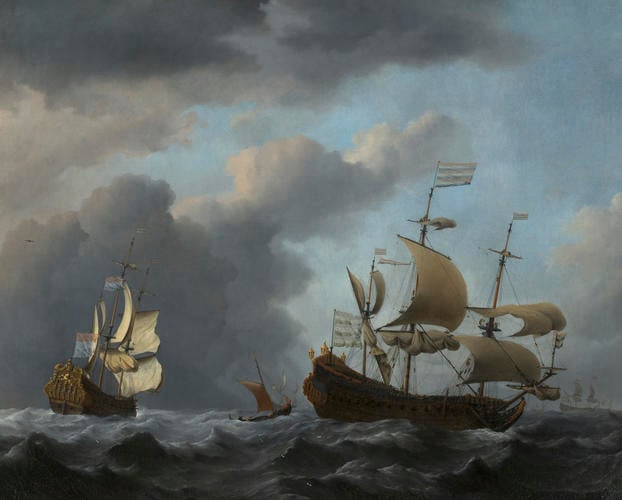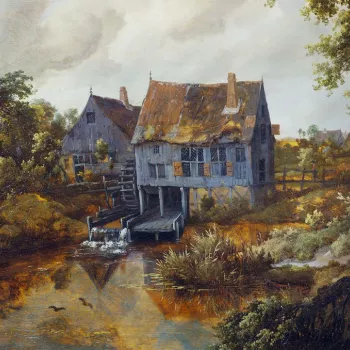The 'Golden Leeuw' at Sea in Heavy Weather 1671
Oil on canvas | 66.1 x 82.9 cm (support, canvas/panel/stretcher external) | RCIN 405324

Willem van de Velde the Younger (1633-1707)
The 'Golden Leeuw' at Sea in Heavy Weather 1671
-
The character of this image derives from ‘ship-spotter’ prints by such artists as Reinier Nooms, called ‘Zeeman’, whose Verscheyde schepen en gesichten van Amstelredam (Various Ships and Views of Amsterdam) show similar ships in pairs, offering alternative views. The van de Veldes take up this idea but show the same ship twice, from different points of view, which is what Willem van de Velde the Elder does in his ‘pen paintings’ and Willem van de Velde the Younger does in this case.
The Gouden Leeuw (Golden Lion) was a Dutch warship built in 1666 and recorded in a drawing by Willem van de Velde the Elder; this painting probably depicts the ship in 1671 when captained by Willem Joseph van Ghent (and before the artist defected to Britain in 1672). Its stern view to the left includes the Golden Lion on its taffrail and the starboard view to the right shows the same emblem as the figurehead. A galliot, the type of ship used by Willem van de Velde the Elder when following the fleet, sails between the ‘two’ ships.
This image also belongs to the tradition of the symbolic ship in peril: the crews of both ships are mounting the rigging most precariously to take in sail, several of which are flapping dangerously; the left-hand ship sails against grey clouds in the thick of the storm; the right-hand ship seems to be sailing out of the worst of the danger towards blue skies. The flock of gannets fishing in the stormy water adds to the menace. The suggestion that this is about more than one ship is strengthened by the fact that warships generally have symbolic or patriotic names. The Golden Lion is the Dutch national emblem: the rampant heraldic lion which appeared on the arms of many of the Seven Provinces of the Netherlands and became the heraldic emblem of their unity. The ‘Dutch Lion’ occurs in countless allegories; many maps of the region are manipulated into the shape of a rampant lion. Van de Velde makes the ships stand out against the background, first light against dark (the gold of the heraldic lion singing out against the grey); and then dark against light, the effect of an aureole rather like that seen in Willaerts’s 'Embarkation at Margate' (RCIN 404994).
Signed on the flag in the stern: W.V. Velde.Provenance
Purchased by George IV in 1820 from Alexis Delahante; added to the Carlton House inventory dated 1816 (no 572) and 1819 (no 567); in the Picture Gallery at Buckingham Palace in 1841 (no 134)
-
Medium and techniques
Oil on canvas
Measurements
66.1 x 82.9 cm (support, canvas/panel/stretcher external)
84.0 x 106.7 x 7.0 cm (frame, external)
Category
Object type(s)
Other number(s)








